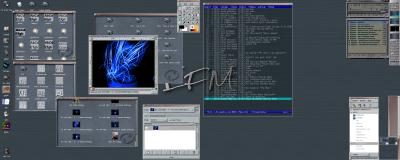Matrox Millennium G450 Under Linux
by Jeff Brubaker on September 19, 2000 12:00 PM EST- Posted in
- GPUs
Using the G450
When the card was finally set up, X started up with Xinerama and fired up both monitors like it was supposed to, but reversed them. What was supposed to be the second display was coming out of the port labeled "Monitor 1" on the card. No big deal but this setup remained even after leaving X. Now the secondary display was showing the console. This was quite annoying actually because the second display is an old Sun GDM-20D10 monitor that can't handle such frequencies. Other than the switched monitor voodoo, the card worked extremely well. There were no display defects while using Dual Head and everything worked just as in the other machine which uses two video cards for dual head display.
Here's a (really, really big) screenshot of X running with Dual Head enabled. The window manager is Enlightenment. Other applications include EFM (file manager), GIMP (paint program), Eterm (terminal), GKrellM (system monitor), XMMS (MP3 player) and Gabber (Instant messenger).
So why bother with Dual Head? The best use for Dual Head has got to be for the developer. Having all of your code on one monitor while debugging or referencing documentation on the other is absolutely amazing. Even for the average user, it's nice to have your mail on one screen along with a program such as Gabber to perform instant messaging while web browsing or working on the other screen. Typically, one must increase resolution to the point of being unreasonably small on their monitor to achieve desktop real estate. With Dual Head, it's possible to read everything AND have the real estate, assuming you have the monitors to handle the duty. Still, with old workstation monitors going for dirt cheap these days, it should be possible for almost anyone to have a dual head machine. Further, Matrox now supports DVI and TV out with their drivers, making one's Dual Head options far more interesting under Linux. TV output is great for gaming, where screen size is more important than resolution most of the time.
Now, remember, this is a 2D only, Xinerama display. For accelerated OpenGL using DRI, one has to forego the Xinerama extension. This should mean that the primary display can be accelerated and while the secondary display is unaccelerated. We did not try this, but we did try with Xinerama enabled, just for the off chance that indirect rendering might work. Unfortunately, the result was software rendered OpenGL for everything.
The following is an example XF86Config excerpt that enables DRI:
Section "Module"
Load "dbe"
Load "type1"
Load "freetype"
Load "extmod"
Load "glx"
Load "dri"
EndSection
Section "DRI"
Mode 0666
EndSection
The two modules related to 3D acceleration are the last two. The DRI section allows non-root users to use DRI. The two most common mistakes with people trying to get DRI to work is missing this in their XF86Config file and using Mesa's libGL.so files. Let us expand a little on that second issue. Most distributions ship with Mesa, a free OpenGL implementation. Without the proper DRI hooks, you won't see any 3D acceleration. So, when installing XFree86, make sure to check in /usr/lib and /usr/X11R6/lib to make sure the right version is there. A good way to check is to simply use strings, strings libGL.so.1 | grep DRI. If anything comes back, you're using the right version.











0 Comments
View All Comments